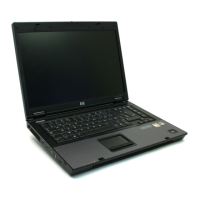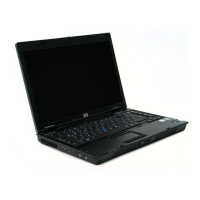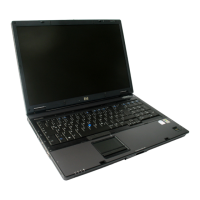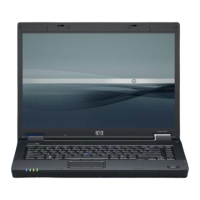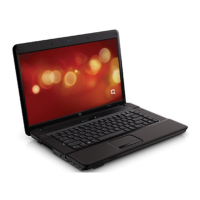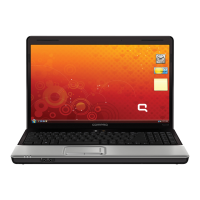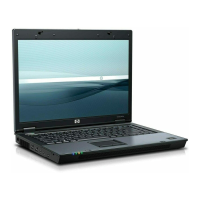Do you have a question about the HP 8710p - Compaq Business Notebook and is the answer not in the manual?
| Processor | Intel Core 2 Duo |
|---|---|
| Chipset | Intel PM965 Express |
| RAM | Up to 4GB DDR2 SDRAM (667 MHz) |
| Storage | 80/120/160 GB 5400 rpm SATA hard drive |
| Display | 1680x1050 |
| Operating System | Windows XP Professional |
| Wireless | Intel Wireless WiFi Link 4965AGN |
| Ports | VGA, S-Video |
| Optical Drive | DVD-ROM |
Detailed specifications for computer models, including dimensions, power, and environmental factors.
Technical details for the 17.0-inch WUXGA+WVA display, covering resolution, brightness, and viewing angle.
Technical details for the 17.0-inch WSXGA+WVA display, covering resolution, brightness, and viewing angle.
Technical details for the 17.0-inch WXGA+WVA display, covering resolution, brightness, and viewing angle.
Specifications for various hard drive capacities, including dimensions, interface, and performance metrics.
Technical specifications for the DVD±RW/CD-RW combo drive, detailing disc compatibility and data transfer rates.
Technical specifications for the DVD/CD-RW combo drive, detailing disc compatibility and data transfer rates.
Technical specifications for the DVD-ROM drive, detailing disc compatibility and data transfer rates.
Details on Direct Memory Access (DMA) channels and their system functions.
Information on memory addresses and their corresponding system functions.
Mapping of hardware IRQ lines to their system functions.
Allocation of I/O addresses to specific system functions for hardware communication.
Identifies and describes components on the computer's display, like sensors and microphones.
Locates and explains the function of top-mounted components such as power buttons, keys, and lights.
Details the functionality of the pointing stick and touchpad, including their buttons and scroll zones.
Identifies and describes components located on the front of the computer, including lights and media card readers.
Identifies and describes ports and slots on the left side of the computer, such as USB and HDMI.
Identifies and describes components located on the rear of the computer, primarily vents for cooling.
Identifies and describes ports and drives on the right side of the computer, including audio and network jacks.
Identifies and describes components located on the bottom of the computer, such as battery bay and docking connector.
Explains where to find the computer's serial and model numbers for service requests.
Provides a visual breakdown and part numbers for major computer components like the display and keyboard.
Lists the components included in the plastics kit and their spare part numbers.
Lists the cables included in the cable kit and their spare part numbers.
Lists spare part numbers for hard drives and optical drives.
Lists spare part numbers for various accessories like AC adapters and power cords.
An index of spare part numbers, organized sequentially for quick reference.
Outlines essential tools, service considerations, and precautions before component removal and replacement.
Provides guidelines for safely handling and routing computer cables and connectors during service.
Specifies precautions for handling fragile storage drives to prevent damage and data loss.
Explains electrostatic discharge (ESD) risks and methods to prevent damage to electronic components.
Provides grounding guidelines for safely packaging and transporting computer equipment.
Outlines procedures for setting up a safe, static-free workstation for electronic component handling.
Recommends grounding equipment and materials to prevent electrostatic damage to computer parts.
Steps to clear the computer's CMOS and reset user passwords if unknown.
Instructions for safely removing and replacing the computer's battery.
Procedures for replacing the display inverter and ambient light sensor board.
Step-by-step instructions for removing and replacing the computer's hard drive.
Instructions for removing and replacing the Bluetooth wireless module.
Procedures for accessing and replacing the computer's primary memory (RAM) modules.
Steps for removing and replacing the Wireless Local Area Network (WLAN) module.
Instructions for removing and replacing the Real-Time Clock (RTC) battery.
Step-by-step guide for removing and replacing the computer's optical drive.
Detailed instructions for removing and reinstalling the computer keyboard.
Instructions for removing and replacing the computer's touchpad.
Procedures for removing and replacing the computer's modem module.
Instructions for removing and replacing the computer's switch cover.
Procedures for removing and replacing the computer's power button board.
Procedures for removing and replacing the fan and heat sink assembly for thermal management.
Instructions for removing and replacing the computer's graphics card.
Procedures for removing and replacing the processor heat sink.
Step-by-step guide for safely removing and installing the computer's processor.
Instructions for removing and replacing the entire computer display assembly.
Procedures for removing and replacing the computer's top cover.
Instructions for removing and replacing the computer's speaker assembly.
Detailed steps for removing and replacing the main system board.
Procedures for removing and replacing the USB and audio interface board.
Instructions for removing and replacing the PC Card assembly.
Guide on how to access and initiate the computer's setup utility.
Information on navigating menus, selecting options, and exiting the computer setup utility.
Overview of available options within the File, Security, Diagnostics, and System Configuration menus.
Comprehensive technical specifications of the computer, including dimensions, power, and environmental limits.
Detailed technical specifications for the 17.0-inch WUXGA+WVA display panel.
Detailed technical specifications for the 17.0-inch WSXGA+WVA display panel.
Detailed technical specifications for the 17.0-inch WXGA+WVA display panel.
Technical details and performance metrics for various hard drive models used in the computer.
Specifications for the optical drive's read and write capabilities for various disc types.
Specifications for the optical drive's read and write capabilities for various disc types.
Specifications for the DVD-ROM drive's read capabilities for various disc types.
Information on the Direct Memory Access (DMA) channels assigned to system functions.
Details memory addresses and their system functions, including base and video memory.
Lists hardware interrupts (IRQ) and their corresponding system functions.
Maps I/O addresses to system functions for hardware device interaction.
Details of the Phillips PM2.0x17.0 captive screw, including color, quantity, and application.
Details of the Phillips PM2.5x13.0 captive screw, including color, quantity, and application.
Details of the Phillips PM3.0x4.0 screw, including color, quantity, and application.
Details of the Phillips PM2.5x5.0 captive screw, including color, quantity, and application.
Details of the Phillips PM2.0x4.0 screw, including color, quantity, and application.
Details of the Torx TM2.5x9.0 screw, including color, quantity, and application.
Details of the Torx TM2.5x4.0 screw, including color, quantity, and application.
Details of the Phillips PM2.5x7.0 screw, including color, quantity, and application.
Details of the Torx T8M2.0x10.0 captive screw, including color, quantity, and application.
Details of the Hex Metric HM5.0x10.0 standoff, including color, quantity, and application.
Details of the Phillips PM2.5x7.0 captive screw, including color, quantity, and application.
Details of the Phillips PM2.0x6.0 screw, including color, quantity, and application.
Instructions for creating recovery discs to restore the system to factory settings.
Guidelines and suggestions for regularly backing up important system files and data.
Procedures for backing up individual files and folders to various storage locations.
Steps for creating a complete backup of the hard drive, including the OS and applications.
How to create system recovery points to revert changes made to the computer.
Using HP Backup Scheduler to automate backup tasks at specific intervals or events.
Explains how to recover files or perform a full system restoration using HP Backup & Recovery Manager.
Steps to start a system recovery process directly within the Windows operating system.
Steps to start a system recovery from the dedicated recovery partition on the hard drive.
Instructions for creating recovery discs and backing up data using Windows XP.
Pin assignments and signal descriptions for the 1394 (FireWire) connector.
Pin assignments and signal descriptions for the audio output (headphone) jack.
Pin assignments and signal descriptions for the audio input (microphone) jack.
Pin assignments and signal descriptions for the external monitor connector (VGA).
Pin assignments and signal descriptions for the High-Definition Multimedia Interface (HDMI) connector.
Pin assignments and signal descriptions for the RJ-11 modem connector.
Pin assignments and signal descriptions for the RJ-45 network connector.
Pin assignments and signal descriptions for the Universal Serial Bus (USB) connector.
General requirements for power cord sets, including length, approvals, and electrical ratings.
Country-specific requirements for power cord sets, including accredited agencies and applicable notes.
Guidelines for proper disposal of computer batteries at the end of their useful life.
Instructions for disassembling the display assembly for recycling purposes, noting mercury content.


